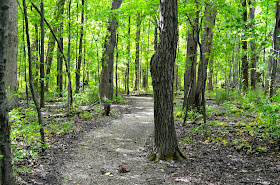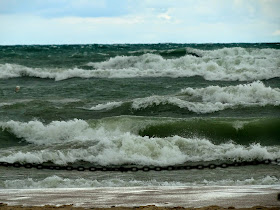After we did our touring in and around the Milwaukee area, including taking in a cheese factory tour in downtown, we left our RV Park at the County Fairgrounds RV Park. If ever in Milwaukee and you need a place to stay for a day or two, I recommend this place. Lots of nice big showers and lots of 50A service, right next to the Milwaukee Mile Racetrack (NASCAR).
Shortly after one leaves Milwaukee you'll run right into Chicago if driving south. It was a little hazy this Saturday morning, Sept 20. Surprisingly, we were able to zip right through town with little delay even though the traffic was heavy.

Indiana Dunes National Lakeshore is a unit of the National Park System designated as a U.S. National Lakeshore located in northwest Indiana and managed by the NPS. It was authorized by Congress in 1966. The national lakeshore runs for nearly 25 miles along the southern shore of Lake Michigan, in Beverly Shores, Indiana. The park contains approximately 15,000 acres. The park is physically divided into 15 disconnected pieces. Along the lakefront, the eastern area is roughly the lakeshore south to U.S. 12 or U.S. 20 between Michigan City, Indiana on the east and the ArcelorMittal steel plant on the west. A small extension, south of the steel mill continues west along Salt Creek to Indiana 249. The western area is roughly the shoreline south to U.S. 12 between the Burns Ditch west to Broadway, downtown Gary, Indiana. In addition, there are several outlying areas, including; Pinhook Bog, in LaPorte County to the east. The Heron Rookery in Porter County, the center of the park, and the Calumet Prairie State Nature Preserve and Hobart Prairie Grove, both in Lake County, the western end of the park. Also within the National Lakeshore is the Hoosier Prairie State Nature Preserve, managed by the Indiana Department of Natural Resources.
This beach was a real surprise. Being from Virginia Beach, and familiar with beaches along the east coast and Florida, I guess we just never gave it a thought the the Lakes region could have such nice large beaches. And the oh the sunsets! Gorgeous!
We parked in the Beverly Shores (town) beach parking lot. We saw the signs that stated private and decal controlled, but hey, it was late Sept and almost dark. Who would have known that a cop had nothing better to do than to hide his cruiser in the reeds and wait for suckers from out of state to donate $85 to the Policeman's Balls. Needless to say we were furious and paid the ticket before we left town, but Nancy was certainly ready to head south, way south, away from these money-grubbing snobs. We won't be back, at least in this lifetime. And what's worse, exactly 100 yards down the access street was the NPS parking lot open to all Americans, including snobs. Oh well, live and learn. Fooled us once! Never again! Sorry for the rant...
The Century of Progress Architectural District, a part of the eastern unit of the National Lakeshore, is an historic district on Lake Front Drive in Beverly Shores, Porter County, Indiana. The district comprises five buildings, all from the Homes of Tomorrow Exhibition during the 1933 Century of Progress World's Fair which took place in Chicago. Intended to display the future of housing, the Century of Progress Homes reflect a variety of designs, experimental materials and new technologies. On June 30, 1986, the district was listed on the National Register of Historic Places as the Beverly Shores—Century of Progress Architectural District.
After the closing of the 1933 World's Fair, in late winter 1935 the Century of Progress houses were moved from Chicago to Indiana. Robert Bartlett purchased the homes with the intent of using them to sell more properties in his new residential development called Beverly Shores. Owing to their lakefront location in Chicago and their future lakefront location in Indiana, it was determined the easiest way to transport the homes was by barge. The houses were rolled off the barge on telephone poles onto a heavy timber crib built out into the lake. There were a series of three steps used to raise the house to the level of Lake Front Drive.
Two or three homes were occupied, while two of them were going through refurbishment. They were quite modern, especially for 1933, and what a nice location. The Beverley Shores community by the way, had many large, comfortable shall I say, "cottages". Nothing like Newport, RI, mind you, but, comfortable.
Did I mention the sunsets?
We stayed till the sun went night-night and was tucked in by Lake Michigan.
The Chellberg Farm reflects the challenges of sustainable agricultural success in the sandy dunes of the lakeshore and represents just one of the many European immigrant waves that moved through the region.
Below, we found this NPS Ranger taking down the old apple press at the farm. It was Monday morning, and we just missed a weekend of demonstrations here, and other locations throughout the Park. :-(
This easy to moderate hiking trail consists of two loops with extensions connecting to the Little Calumet River Trail and the Indiana Dunes Environmental Learning Center totaling 2.1 miles of shady woods, ravines, wetlands and grassy meadows, and a one way trail that leads to the Bailly Cemetery. We walked to the family cemetery which we found interesting. So much effort it seems, in an attempt we learned from the ranger, to protect the plots from grave robbers. Hmmm!
This circular "driveway" was used by the horse-drawn carriages to transport the coffins to the cemetery, which was probably about a mile from the farm house.
It was an easy walk, but nonetheless, a 2.5 mile round trip hike. Late September, but most leaves are still green.
We stopped to chat with a couple of volunteers who happened to be tending to the garden at the farm house. There were a number of veggies and herbs being grown in the garden and all the work cultivating and planting and maintaining was being accomplished using period tools. Whew! They were actually turning the soil over using shovels.
In 1822, fur trade pioneer Joseph Bailly established a trading post on the southern shore of Lake Michigan. He acquired the homestead and surrounding lands in the 1830s. Bailly Homestead was designated a National Historic Landmark in 1962 and is preserved by the National Park Service.
We parked at the Walmart in Michigan City for a couple nights while visiting the Lakeshore District and the last day we decided to drive into the little town to check out the lighthouse and surf. Yep, surf! The wind was right out of the north west and it was howling. The sand was whipping against the windshield and sounded like little hail balls.
Well, that about wraps up our visit to the IDNLS and it was informative if not an enlightening experience, this treasure just east of Gary, IN and Chicago. So, till the next blog, RVing Beach Bums signing off. This blog written and published on December 17 from our home in Virginia Beach.









































No comments:
Post a Comment